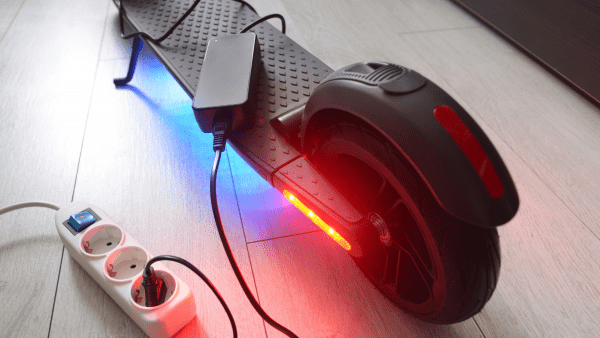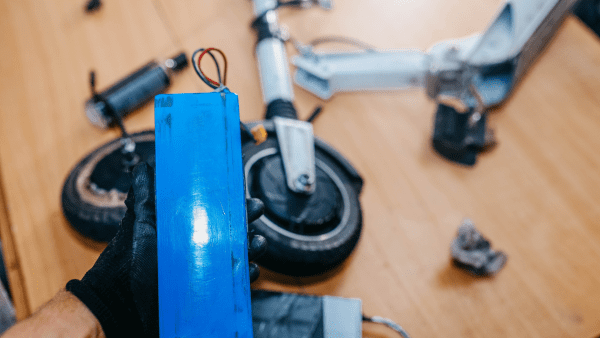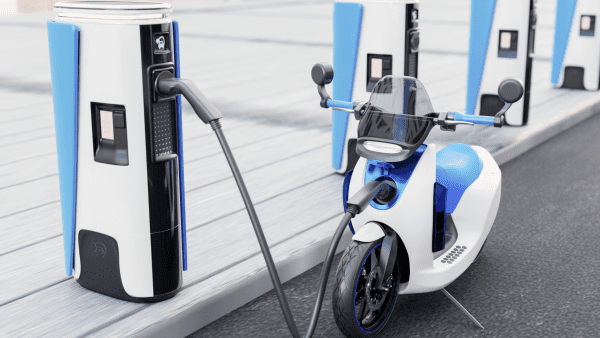Are you curious about the lifespan of your electric scooter’s battery? You’re not alone. Understanding the longevity and health of your e-scooter’s power source can help you maintain it better, saving both time and money.
This article from FamilyHype will guide you through the basics of an electric scooter battery, the factors that influence its life, and how to recognize when it’s on its last legs. We’ll also share practical tips on how to extend its longevity and responsibly replace or dispose of old batteries.
Battery life is an important factor to consider when purchasing an electric scooter, as it affects the range you can travel and how long the scooter will last.
We can break down the longevity of an electric scooter cell into four categories: charge time, discharge time, cell health, and cell age. Charge time refers to the time it takes to recharge a battery, while discharge time is the amount of time a battery can operate before needing to be recharged. Battery health is determined by how often and how deeply you discharge the cell, and cell age is determined by how many charge cycles it has gone through.
Knowing the factors that influence an electric scooter battery’s longevity is important, but that doesn’t mean it has to be complicated. With some simple tips, you can prolong the life of your battery and get the most out of your investment.
First and foremost, avoid deep discharges, as they can cause permanent damage to the electric scooter battery. Secondly, make sure to store your e scooter battery in a cool, dry place when not in use, as extreme temperatures can negatively affect electric scooter battery life. Lastly, if it’s time to replace your lithium batteries, make sure to dispose of the e scooter battery responsibly. We strongly believe in taking care of our environment and community, so we encourage you to do your part and recycle your old mobility scooter batteries or take them to a certified recycling center.
We hope this article has given you a better understanding of the longevity of an electric scooter battery and how to maintain it. Maintaining your scooter battery life properly is essential to getting the most out of your electric scooter. If you have any tips you’d like to share with our readers, please leave them in the comments. Thank you for reading and we hope you have a safe and enjoyable ride!
Key Takeaways
Electric scooters are becoming a popular way for families to efficiently and cost-effectively travel around town. But how long does the battery last? We value reliable transportation for families and understand the importance of a scooter battery’s longevity. On average, with proper care, an electric scooter battery can last between 2 to 4 years. Signs that the battery is dying include reduced range or changes in acceleration.
To ensure your electric scooter battery lasts its longest, you should consider several factors such as charging, temperature, and battery type. For instance, lithium-ion batteries, which are common in electric scooters, are best when charged at a slower rate. Keeping your scooter in an environment that is not too hot or cold will also help prolong the battery’s life.
When it’s time to replace the battery, make sure to dispose of it responsibly. With the right care, your electric scooter’s battery can have a long and reliable longevity, allowing you to enjoy your scooter for years to come.
Understanding Electric Scooter Battery Basics
Imagine you’re zipping around town on your electric scooter, the wind whipping through your hair. To keep that feeling going, it’s crucial to understand the basics of your scooter’s cell, which is essentially the heart of your ride.
Knowing about different Cell Types, such as lead-acid, lithium-ion, and nickel-metal-hydride, and how they impact Scooter Performance can help in maintaining a long-lasting relationship with your scooter.
Factors such as cell capacity, voltage, charge cycles, and charging time all influence the life of your cell.
We understand the importance of finding an electric scooter that meets your needs, and that starts with understanding battery basics.
Now let’s delve into what factors influence this battery life.
Factors Influencing Battery Life
When it comes to the longevity of your electric scooter’s cell, several factors come into play. The quality of the cell itself is a major determinant, but don’t underestimate the impact of your usage frequency and charging habits.

Understanding these aspects can help you maximize your ride’s power source, ensuring you get from point A to B smoothly and efficiently every time.
Quality Of The Cell
The quality of your electric scooter’s cell can be a game-changer. It’s like the heart pumping life into your ride; if it’s robust and well-made, you’re looking at years of smooth scooting.
To ensure that your electric scooter battery is of the highest quality, we recommend prioritizing cell maintenance. Keep it clean and dry, seek sustainable manufacturing with eco-friendly practices, check warranty periods (as longer usually means a better build), and note brand reputation (as trusted brands often deliver).

Additionally, the frequency of use can significantly impact the longevity of your cell. So be sure to factor that into your decision-making.
As you navigate the world of electric scooters, our team is here to provide advice and feedback to help you find the perfect ride.
Frequency Of Use
The frequency of use of your electric scooter plays an important role in determining its longevity. Long trips without allowing the cell to rest can reduce efficiency and battery life. Thus, it is important to consider your charging habits when it comes to the longevity of your scooter’s power source.
We’re dedicated to helping parents and people who value the family unit to understand the various components of their electric scooters.
Using these words and concepts, it’s possible to understand how to best maintain and extend the life of your electric scooter. We hope this article has given you some insight into how the frequency of use of your scooter can affect its longevity, and we encourage you to share your feedback and experience with us.
Charging Habits
Believe it or not, your charging habits can significantly influence the efficiency and longevity of your electric ride’s power source. Different cell types require specific maintenance routines to stay in top condition. Overcharging, for example, can harm your scooter’s cell life.

Our writers and editors, all of whom are either parents or people that highly value the family unit, understand this and want to provide our readers with reliable transportation. That’s why we’re shifting our focus towards understanding the average longevity of an electric scooter battery more broadly.
All of these factors play a huge role in the longevity and efficiency of electric scooters.
So, let’s focus on understanding the average longevity of an electric scooter battery and the various factors that come into play.
Average Lifespan Of An Electric Scooter Battery
Electric scooter batteries, including lead acid batteries and lithium ion battery, have an average longevity of 1 to 3 years, but proper care and maintenance can help them last longer. We understand the joy of riding your scooter without worrying about battery failure. We want to equip our readers with knowledge of different battery brands, scooter models, and how to preserve battery health.
Electric scooters are part of the transportation industry, and the key components include the battery, motor, controller, and frame. Each type of battery, such as lead acid batteries and lithium ion batteries, has its own distinct characteristics such as energy density, charging time, and cycle life.
When it comes to preserving battery health, there are certain steps you can take. These include avoiding extreme temperatures, using the right charger for lead acid batteries or lithium ion batteries, and not overcharging. These tips are essential for prolonging battery life and preserving the longevity of your electric scooter battery. Additionally, it’s important to consider replacement battery options and advancements in battery technology to improve battery cells and achieve longer battery lifespan, especially for mobility scooter use.
With a better understanding of battery maintenance, you can feel proud of your newfound knowledge and be confident in the longevity of your scooter.
We at FamilyHype hope this article was beneficial in giving you an insight into electric scooters, cell types, and battery maintenance. Remember, sharing your experience, opinions, and feedback is always appreciated.
Signs Of A Dying Battery
Hitting the streets, you’ll quickly notice when your ride on a mobility scooter fully charged starts to lose its zip and power — clear signs of a fading energy source. Regular battery maintenance can help prevent unexpected shutdowns, but even with consistent care, every cell has its limits in direct sunlight. If you’re experiencing decreased performance, it might be time to refresh your understanding on how to effectively prolong the life of your scooter’s battery and consider the watt hours it can provide.
FamilyHype, a website dedicated to helping parents and people who value the family unit, wants to remind you of the importance of cell maintenance, including the use of an aftermarket charger.
Taking care of your scooter’s cell is essential to ensure it stays in top condition and helps you get the most out of your ride, especially in extreme heat. We hope this article gave you a better understanding of the signs of a dying cell, the impact of power output, and how to effectively prolong its life even among many electric scooters. Feel free to share your feedback and experience with us!
How To Maximize Battery Lifespan
When it comes to electric scooters, it’s essential to understand how to maximize the cell longevity. We know parents and those who highly value the family unit are often looking for ways to make their scooters last longer. So, here are some tips on how to keep your power source humming for the long haul.
Consider these four pointers:
- Recognize the different types of batteries used in electric scooters, such as Li-ion, Sealed Lead Acid (SLA), and Nickel-Metal Hydride (NiMH).
- Regularly inspect and maintain your battery. This includes checking for corrosion and dirt buildup, as well as making sure all connections are secure.
- Use protective measures, such as keeping batteries dry and at moderate temperatures.
- Don’t overcharge or completely drain the battery.
Finally, when it comes time for replacing and disposing of electric scooter batteries, it’s important to take into account safety precautions and local disposal regulations. We hope these tips have been helpful in maximizing your cell longevity.
Replacing And Disposing Of Electric Scooter Batteries
When it comes to electric scooters and e-scooters, replacing and disposing of the cell is an important task. We understand the importance of being mindful of the environment and we’re dedicated to helping you do your part in preserving it.
In order to properly dispose of your scooter batteries, it’s important to recycle them responsibly. Through battery recycling, we can prevent harmful materials like thermal runaway and absorbent glass mats from entering our environment and create sustainable alternatives.
We encourage you to make every small act like charging overnight count and choose battery disposal with care! Please share your experiences and thoughts about battery disposal, maximum capacity, more power, and battery size, on our website, as your feedback is important to us.
Together, we can make a difference in the world.
Conclusion
Electric Scooters are becoming increasingly popular amongst families, providing an efficient and cost-effective way to travel around town. However, the battery life of an electric scooter is an important factor to consider when considering which scooter to buy.
So, what is the longevity of an electric scooter battery? On average, with good care, a scooter battery can last between 2 to 4 years. Although this isn’t set in stone, there are some signs that the battery is dying, such as reduced range or changes in acceleration.
To maximize its longevity, it’s important to consider factors such as charging, temperature, and the type of battery. We understand the importance of reliable transportation and we want to provide our readers with the best information available. That’s why we encourage our readers to provide us with feedback on their experience with electric scooters and their batteries, as well as any opinions they may have.
When it’s time to replace the battery, it’s important to dispose of it responsibly. With the right care, your electric scooter’s battery can have a long and reliable longevity, allowing you to enjoy your scooter for years to come.
(FAQs)
How Long Will An E-Scooter Battery Last?
The electric scooters’ battery life can vary depending on their charge capacity, but it typically lasts for a few hours to a day-long ride. On average, electric scooter batteries can last between 1 to 3 years, but with proper care, they can last longer.
Can An E-Scooter Last 10 Years?
It is unlikely that an electric scooter will last 10 years without requiring significant repairs or battery replacements. The longevity of an electric scooter depends on various factors, including the quality of components, usage patterns, maintenance, and technological advancements.
How Many Hours Does An E-Scooter Last?
The battery life of an electric scooter varies, but electric scooters typically last for several hours on a single electric scooter battery charge. Also, the operational duration of an electric scooter on a full battery charge can vary depending on factors such as the scooter’s model, battery capacity, speed, weight of the rider, and terrain. On average, electric scooters can provide a range of 1 to 4 hours of continuous riding before requiring a recharge.
How Do I Keep My Electric Scooter Battery Healthy?
To keep your e-scooter battery healthy, follow these tips:
1) Charge the battery regularly, even if not in use, to prevent deep discharges.
2) Avoid exposing the battery to extreme temperatures.
3) Avoid overcharging the battery.
4) Store the scooter in a cool and dry place.
5) Follow the manufacturer’s guidelines for battery maintenance.
What Happens When An Electric Scooter Battery Dies?
When an e-scooter battery dies, the scooter will no longer function until the battery is recharged or replaced. The scooter may become inoperable, and you will need to charge the battery or find a power source to continue using it.
How Many Kilometers Do Scooters Last?
The total distance that a scooter can travel, known as its range, can vary depending on factors such as battery capacity, scooter model, rider weight, speed, terrain, and weather conditions. On average, e-scooters can travel around 15 to 50 kilometers (9 to 31 miles) on a single charge.
How Do I Prolong My Electric Scooter Battery?
To prolong the longevity of your e-scooter battery, you can follow these tips:
1. Avoid deep discharges by charging the battery regularly.
2. Avoid overcharging the battery.
3. Keep the battery at a moderate temperature range.
4. Avoid exposing the battery to extreme temperatures.
5. Store the scooter in a cool and dry place.
6. To prolong your electric scooter battery life, use proper charging practices for lithium-ion batteries.
Should I Leave My E-Scooter Charging All The Time?
It is generally not recommended to leave your e-scooter charging continuously for extended periods, as it can potentially overcharge the battery and lead to reduced battery performance or premature degradation. It is advisable to follow the manufacturer’s guidelines regarding charging duration and to unplug the scooter once it is fully charged.
How Many Kilometers Is An Electric Scooter?
The total distance an e-scooter can travel on a single charge, known as its range, can vary depending on factors such as battery capacity, scooter model, rider weight, speed, terrain, and weather conditions. e-scooters can typically have a range of 15 to 50 kilometers (9 to 31 miles) or more, depending on the specific scooter and usage conditions.
How Often Should I Charge My Electric Scooter?
To maintain electric scooter battery life, charge it as needed but avoid overcharging, which can damage the battery, especially with lithium-ion batteries.
The frequency of charging your e-scooter depends on how often you use it and how much battery capacity is consumed during each ride. As a general guideline, it is recommended to charge the scooter whenever the battery level drops to around 20-30% or according to the manufacturer’s recommendations. Avoid leaving the battery fully discharged for extended periods.
DISCLAIMER (IMPORTANT): This information (including all text, images, audio, or other formats on FamilyHype.com) is not intended to be a substitute for informed professional advice, diagnosis, endorsement or treatment. You should not take any action or avoid taking action without consulting a qualified professional. Always seek the advice of your physician or other qualified health provider with any questions about medical conditions. Do not disregard professional medical advice or delay seeking advice or treatment because of something you have read here a FamilyHype.com.